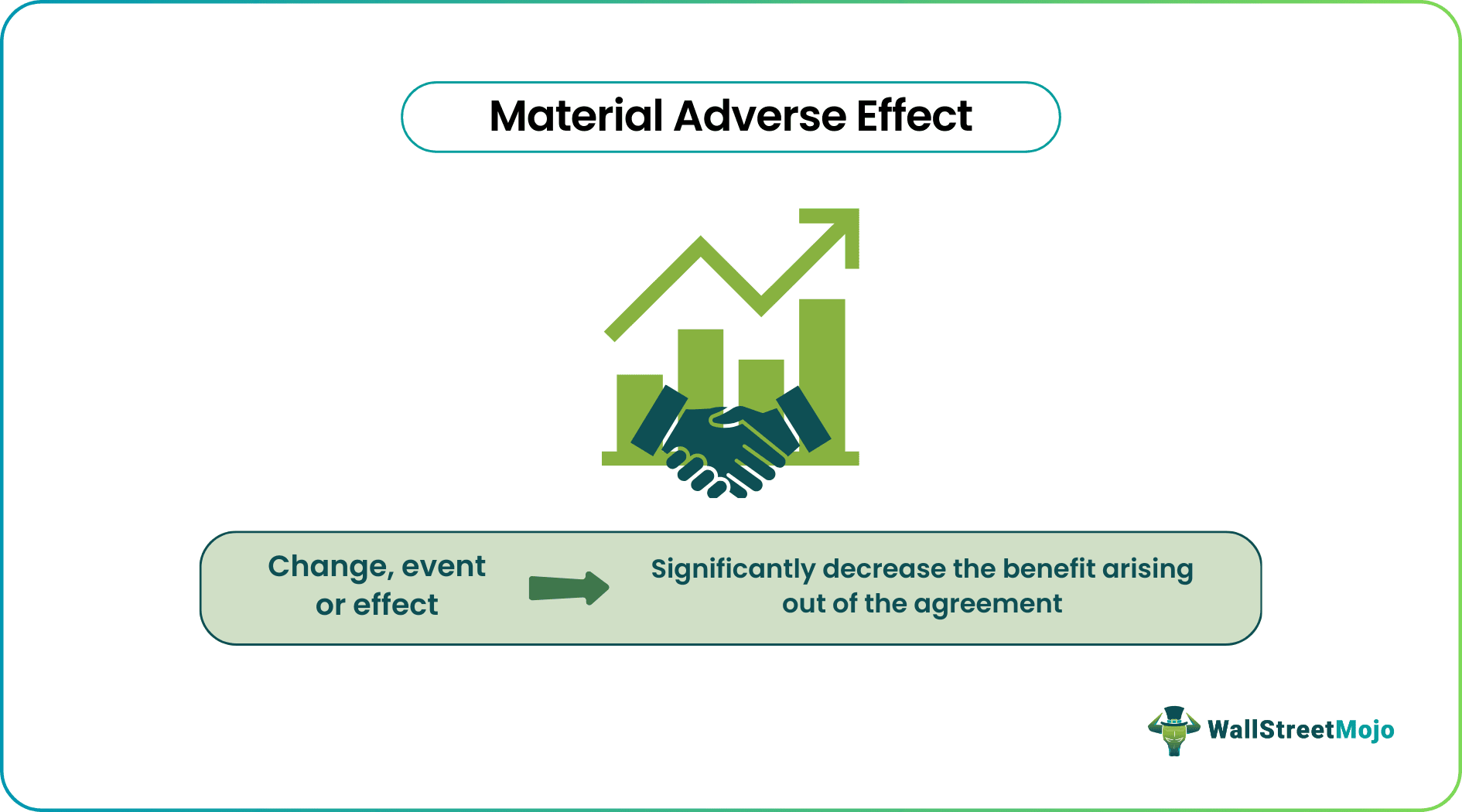Table Of Contents
Material Adverse Effect Definition
A material adverse effect (MAE) or material adverse change (MAC), or material adverse event (MAE) refers to a specific happening that decreases the value of an entity or interest toward a matter under consideration. It is a contractual term helping the investor to cancel the transaction if a significant disadvantageous change occurs.

Its usage is relevant when there is a significant gap between contract signing and transaction completion. During this gap, unfavorable events or changes can affect the contract's benefit. A material adverse effect, change, or event is not the same for every contract or agreement but unique to each contract or agreement.
Key Takeaways
- The material adverse effect is any event, change, circumstance, effect, or state of facts materially adverse to the target company's business or financial situation.
- MAE clause is a common clause found in mergers and acquisitions (material adverse effect m&a) and lending agreements that affect the closing of a deal.
- It can significantly benefit parties of the contract affected by material adverse effects.
- Investment and symmetry theories determine the usefulness of the MAE provisions during mergers and acquisitions.
- The MAE clause's definition of "material" is objective and does not depend on what the claimant thinks is "material."
Material Adverse Effect Explained
The material adverse effect clause allows a party to withdraw from a contract if anything happens or is disclosed is not in line with the agreement's content after the contract signing. Such clauses are commonly enforced during purchase and lending agreements. For example, the MAE clause in merger and acquisition agreements allows the buyer to exit from the deal. In the case of lending agreements, this clause gives the lender an option not to pay advance or give a loan to the borrower as per the agreement.
Clauses
MAE clauses can be very broad and ambiguous. It typically depends on the type of transaction, the parties' bargaining power, the market regulations at the negotiation time, and several external factors. The external factors may include a change in the socio-political environment and the state of the economy. Only "substantial" change constitutes an MAE; a general adverse change is not part of an MAE. The court decides whether the specific change in question is material based.
Material adverse effect clauses are a common method of mitigating a buyer's risks during acquisition due to adverse business or economic developments. The main goal of including an MAE clause in a transaction agreement is to give the buyer the option to withdraw before transaction completion or to provide a basis for renegotiating the transaction if the seller's business suffers a significant negative change. The change can be any change to the seller's assets, liabilities, or business operations jeopardizing the buyer's deal.
Including the material adverse effect clause in a loan agreement provides security to the investor, buyer, or lender in the case of a significant adverse change. The situation may occur from the date of the agreement or transaction or at any time afterward. The two theories, i.e., symmetry theory and the investment theory, explain the need for the MAE clause:
1. Investment Theory
Without an MAE clause, the investor or buyer does not have enough incentive to make investments. Thus, an effective MAE clause encourages a seller to make investments that reduce the risk of a fall in the value of the business, especially during mergers and acquisitions.
2. Symmetry Theory
The MAE clause is interpreted as a contractual re-allocation of asymmetric risk. During the contract transition period, the seller's business value decreases, but the buyer is bound to complete the contract at a predetermined value. In the absence of the provision, the seller is in a favorable position, and the buyer is at significant risk. The MAE clause becomes crucial during mergers and acquisitions to prevent uneven risk distribution.
Examples
Let us look at the material adverse effect examples to understand the concept better:
Example #1 - Elon Musk & Twitter Legal Battle
Entrepreneur Elon Musk wants to back out of his Twitter purchase agreement. Musk claims that Twitter's failure to disclose sufficient information on its bots and its alleged underrepresentation of the number of bots on its system constitute an MAE, which would entitle him to revoke the purchase.
Example #2 - Hexion Specialty Chemicals, Inc. v. Huntsman Corp. Case
The court denied the request of Hexion, a chemical company based in Ohio, to withdraw from its agreement with Huntsman, a multinational manufacturer of chemical products. The definition of MAE in the Hexion-Huntsman agreement is "Any occurrence, condition, event or effect materially adverse to the financial condition, business or resolutions of operations of , taken as a whole."
A few observations from the court that strengthened the absence of MAE are the following:
- First, Huntsman's inability to achieve the forecast did not result in an MAE.
- The financials of Huntsman disclose that its 2007 EBITDA was a few percent below its 2006 EBITDA. Moreover, 2008 EBITDA is also a few percent below its 2007 EBITDA. But neither of which evidenced an MAE.
- The court found that future performance was likely to fall between Hexion's pessimistic and Huntsman's optimistic projections, which was in line with analysts' expectations.
- Huntsman's net debt expansion of roughly 5–6% was not significant enough to establish an MAE.
